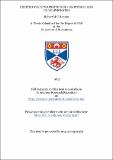Files in this item
Excited state properties of 1-naphthol and its sulphonates
Item metadata
| dc.contributor.advisor | Wyatt, P. A. H. (Peter Arthur Harris) | |
| dc.contributor.author | Henson, Robert M. C. | |
| dc.coverage.spatial | x, 119 p. | en_US |
| dc.date.accessioned | 2018-07-17T15:54:40Z | |
| dc.date.available | 2018-07-17T15:54:40Z | |
| dc.date.issued | 1973 | |
| dc.identifier.uri | https://hdl.handle.net/10023/15507 | |
| dc.description.abstract | The transient absorption spectrum of 1-naphthol was first sought by flash photolysis at higher acidities than had been previously investigated. While no transient absorption was observed for l-naphthol itself, strong transient absorptions were observed for l-naphthol-2 and -4-sulphonates even in aqueous solution. This enabled pK(T₁) for the protonation of the naphtholate ions to be measured directly from the strength of triplet-triplet absorptions and this value was compared with the pK(T₁) obtained from Forster Cycle calculations on phosphorescence maxima,. Values of pK(S₁) and pK(S₀) were also obtained and the order of the pK values was found to be pK(S₀) > pK(T₁) >> pK(S₁), It is likely that this order is the same for l-naphthol and therefore disagrees with the results of some recent quantum mechanical calculations, A strong fluorescence was also observed for l-naphthol-2- sulphonate in aqueous acidic solutions, in contrast with the weak fluorescence observed for 1-naphthol and l-naphthol-4-sulphonate. This is explained in terms of intramolecular hydrogen bonding in l-naphthol-2-sulphonate which prevents quenching of the first excited singlet state by hydrogen bonding with solvent water molecules. The fluorescence intensity of 1-naphthol, l-naphthol-2-sulphonate, and l~naphthol-4-sulphonate in aqueous acidic solutions is also found to increase as the water concentration is effectively reduced by the addition of certain solutes in large quantities, A corresponding increase in the triplet yield is also found for l-naphthol-2-sulphonate in acidic solutions. These increases are also explained in terms of reducing the hydrogen bonding to solvent water molecules and hence reducing the deactivation of the state, l-Naphthol sulphonates and protonates in concentrated sulphuric acid and it is deduced that protonation occurs at a carbon atom in the naphthalene ring, A value of pK(S₀ ) was determined for this protonation. | en_US |
| dc.language.iso | en | en_US |
| dc.publisher | University of St Andrews | |
| dc.subject.lcc | QD561.H3 | |
| dc.title | Excited state properties of 1-naphthol and its sulphonates | en_US |
| dc.type | Thesis | en_US |
| dc.type.qualificationlevel | Doctoral | en_US |
| dc.type.qualificationname | PhD Doctor of Philosophy | en_US |
| dc.publisher.institution | The University of St Andrews | en_US |
This item appears in the following Collection(s)
Items in the St Andrews Research Repository are protected by copyright, with all rights reserved, unless otherwise indicated.

